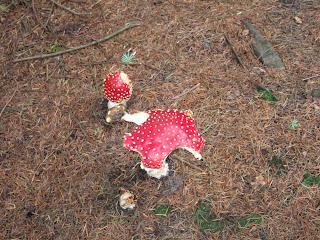
Metal sculpture. Note the horseshoes.
The sea and rocks were the twin stars of this walk. White horses flecked the sea for several hundred meters from the shore, ideal for surfing. Wetsuited young men were parking their 4WDs at the car park at Howdiemont Sands and running eagerly into the sea's embrace, boards at the ready. Despite a noticeable lack of bikinied girls to admire them, some managed a fairly tolerable impersonation of Beach Boys, standing up and riding the waves far out to sea.

Sea at high tide, Howick Haven
The geology on this part of the coast changes constantly. From Boulmer to Howick coarse-grained sandstone rocks jut out into the sea, forming 'steels' or reefs. These give protection for boats in Boulmer harbour. Further up the coast, steels give way to occasional outcrops of limestone and softer sandstone; so soft in fact that Earl Grey (who steered the 1832 Reform Act through parliament and had a particular taste in tea) had a man-made swimming pool gouged out of the rock next to his 'Bathing House' at Howick, just north of the Rumbling Kern bay. We all enjoyed the bay; climbing the rocks, watching the waves rush in and crash on the seaward side or just resting and watching the world go by.

Earl Grey's bathing house, Howick
Just before reaching the bathing hut we came across Howick house mesolithic site, where from 2000 to 2002 an archaeological dig revealed a stone age structure dating 7600 years old - at that time the oldest house ever discovered in Britain. A reconstruction, at half the original size, has been constructed at the excavation site. It has a sunken floor with a central fireplace. The walls are held up with wooden stakes and turfed to keep out the cold and wind. It is estimated that the sea levels after the ice age rose by 50 meters, so this house was much further from the beach than today. I imagi
 ne their lives were nasty brutish and short, but they had a good view.
ne their lives were nasty brutish and short, but they had a good view.From Cullernose Point to Craster the rocks are of igneous (ie volcanic) whinstone. These form part of the Northumberland Whin Sill, whose outcrops of hard columnar basalt are to be found throughout Northumberland. The cliffs at Cullernose are the summer home of a big population of fulmars. They have flown the nest by September, leaving only guano-covered rock until the following spring. These sea cliffs are popular with climbers who like getting their feet wet!
Cullernose Point

The final section ends up in the garden of the Jolly Fisherman in Craster. More of this lovely village next time.









